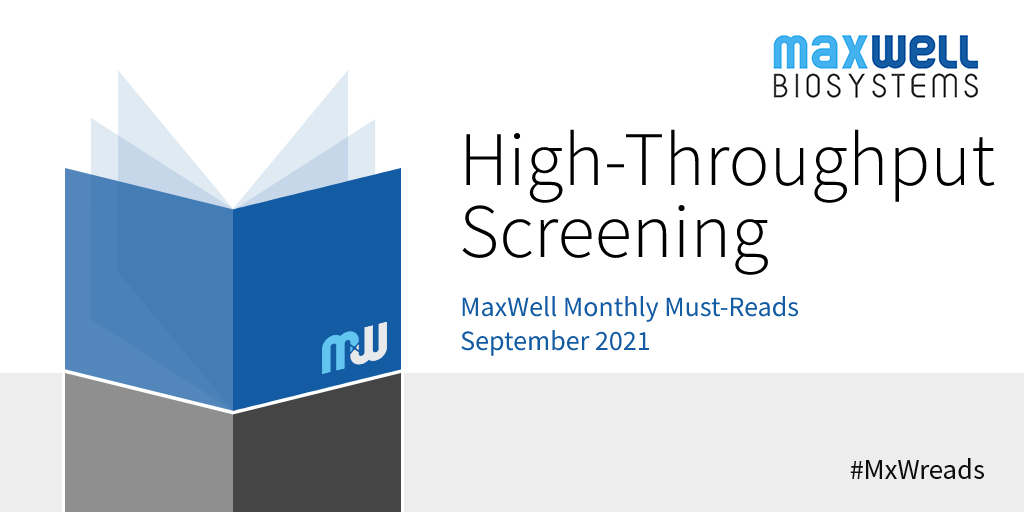

It is time for a new edition of our monthly blog. In the August edition during the summer holidays, we highlighted the latest developments on CMOS-based MEA technology. For the September edition, we decided to focus on high-throughput screening. With these articles, we would like to prepare you for our upcoming webinar which will be a live demo of our multiwell MEA system, MaxTwo. You can still register for this live demonstration here. In this Monthly Must-Reads edition, we highlighted the article written by Renner et al., in which the authors developed a fully automated high-throughput workflow for 3D-based chemical screening in human midbrain organoids.
iPSC Technology for High-Throughput Screenings and Translational Research.
by Renner, H., Grabos, M., Becker, K.J., Kagermeier, T.E., Wu, J., Otto, M., Peischard, S., Zeuschner, D., TsyTsyura, Y., Disse, P., Klingauf, J., Leidel, S.A., Seebohm, G., Schöler, H.R., Bruder, J.M. eLife 9. November 2020.
Induced pluripotent stem cell (iPSC) technology enabled the generation of 2D and 3D human samples, which can be used for translational research and high-throughput screenings (HTS). Currently, there is a significant effort in the standardization of techniques for large-scale production of human iPSC-derived neurons and brain organoids, as well as in the development of high-throughput and multiparametric assays for assessing compound effects.
Renner et al. developed a scalable, HTS-compatible workflow for the generation, maintenance, and functional analysis of human organoids in 96-well plate format. The authors demonstrate that human brain organoids can be grown and tested in a fully automated, reproducible and scalable way by RNA sequencing, high-content imaging, and electrophysiological analysis, in order to test of thousands of compounds for e.g. Parkinson’s disease. As reported in the related 4 articles below, human iPSC-derived 2D and 3D samples have also been used for HTS studies including non-neuronal tissue such e.g. retinal epithelium and gastrointestinal organoids.
In conclusion, the combination of iPSC technology for generating human neuronal samples, HTS platforms, multi-parametric assays, and artificial intelligence (AI)-based data analysis aim to revolutionize translation research and drug screenings for brain disease.
Read the paper here.
Although we decided to highlight the article by Renner et al., we selected four scientific articles that delve into the topic of high-throughput:
- High-throughput automated organoid culture via stem-cell aggregation in microcavity arrays.
by Brandenberg, N., Hoehnel, S., Kuttler, F., Homicsko, K., Ceroni, C., Ringel, T., Gjorevski, N., Schwank, G., Coukos, G., Turcatti, G., Lutolf, M.P.. Nature Biomedical Engineering. June 2020.
Read the paper here. - High-throughput screening of human induced pluripotent stem cell-derived brain organoids.
by Durens, M., Nestor, J., Williams, M., Herold, K., Niescier, R.F., Lunden, J.W., Phillips, A.W., Lin, Y.-C., Dykxhoorn, D.M., Nestor, M.W.. Journal of Neuroscience Methods. April 2020.
Read the paper here. - A Human Retinal Pigment Epithelium-Based Screening Platform Reveals Inducers of Photoreceptor Outer Segments Phagocytosis.
by Schreiter, S., Vafia, K., Barsacchi, R., Tsang, S.H., Bickle, M., Ader, M., Karl, M.O., Tanaka, E.M., Almedawar, S. Stem Cell Reports. December 2020.
Read the paper here. - High-throughput Analysis of Synaptic Activity in Electrically Stimulated Neuronal Cultures.
by Van Dyck, M., Mishra, R.K., Pestana, F., Verstraelen, P., Lavreysen, H., Pita-Almenar, J.D., Kashikar, N.D., De Vos, W.H. Neuroinform. August 2021.
Read the paper here.
 English
English


